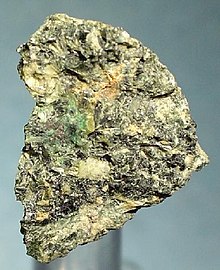Auricupride
| Auricupride | |
|---|---|
 Auricupride | |
| General | |
| Category | Native elements |
| Formula (repeating unit) | Cu3Au |
| IMA symbol | Auc[1] |
| Strunz classification | 1.AA.10a |
| Dana classification | 1.1.2.1 |
| Crystal system | Cubic |
| Crystal class | Hexoctahedral (m3m) H-M symbol: (4/m 3 2/m) |
| Space group | Pm3m |
| Identification | |
| Formula mass | 387.60 g/mol |
| Color | Yellow with reddish tint |
| Fracture | Malleable |
| Mohs scale hardness | 3+1⁄2 |
| Luster | Metallic |
| Streak | yellow |
| Diaphaneity | Opaque |
| Ultraviolet fluorescence | Non-fluorescent |
| References | [2][3][4][5] |
Auricupride is a natural alloy that combines copper and gold. Its chemical formula is Cu3Au. The alloy crystallizes in the cubic crystal system in the L12 structure type and occurs as malleable grains or platey masses. It is an opaque yellow with a reddish tint. It has a hardness of 3.5 and a specific gravity of 11.5.[3]
A variant called tetra-auricupride (CuAu) exists. Silver may be present resulting in the variety argentocuproauride (Cu3(Au,Ag)).[2]
It was first described in 1950 for an occurrence in the Ural Mountains in Russia. It occurs as low temperature unmixing product in serpentinites and as reduction "halos" in redbed deposits. It is most often found in Chile, Argentina, Tasmania, Russia, Cyprus, Switzerland and South Africa.[3][2]
References
- ^ Warr, L.N. (2021). "IMA–CNMNC approved mineral symbols". Mineralogical Magazine. 85 (3): 291–320. Bibcode:2021MinM...85..291W. doi:10.1180/mgm.2021.43. S2CID 235729616.
- ^ a b c "Auricupride: Auricupride mineral information and data". Mindat.org.
- ^ a b c http://www.handbookofmineralogy.org/pdfs/auricupride.pdf Handbook of Mineralogy
- ^ Mineralienatlas
- ^ Webmineral
External links
